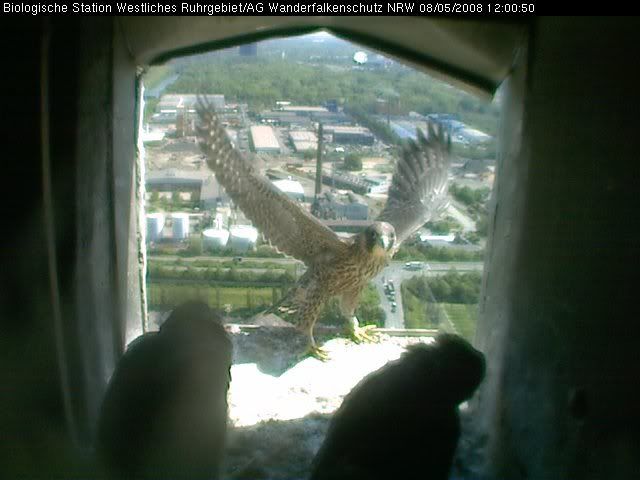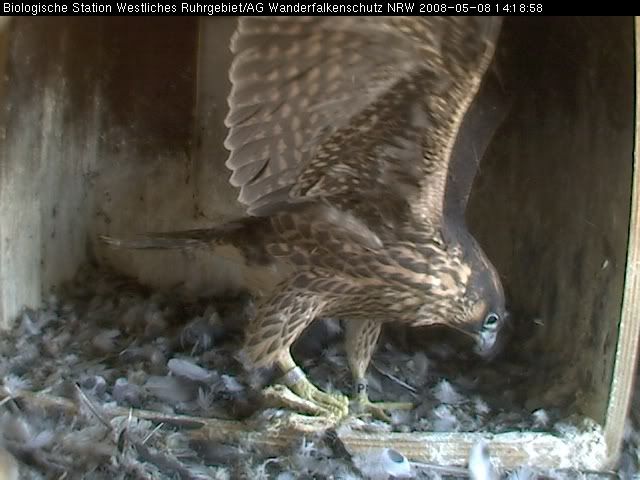

Beautiful fairytale morningviews from the Oberhausen ledge. Such fine colors, it's amazing. The shadows the light makes on the juvi's is so wonderful. They love wingflapping in the early morning on the ledge. It makes awesome pics. To catch the early bird, that will be a pigeon in this case. I wonder how many have to follow before we will see the first one being properly plucked by one of our juvi's. In a way it is sweet to see how they still are very much eyases although from teh outside they look grown juveniles. They are still children.
When they first fledge they scream for joy and fly and tumble laughing through the skies trying to catch eachothers tail. It's a shame we cannot see that. If you are near a nestsite please try for once to see that live. I's great!










3 comments:
Ah, yes, the sheer joy of another sentient being being savagely ripped to pieces without even a hint of concern for the prey. Who cares if they have young in their nest who will never see their mother or father again -- or the parent who will no longer be with their lifelong mate. That's just nature. Others might revel in the convulsive death throws of the Peregrine who dined on a poisoned pigeon -- or rejoice as the falcon spirals to its sudden demise from a shotgun blast. Too bad you display not a shred of compassion for the magnificent Rock Doves who's lives are predated by those ruthless sky-sharks. In a perfect world, all predators would become scavengers and leave their former prey to enjoy the same joys you extol about the winged murderers.
Yeah, didn't think you'd post my previous comment. No wonder you moderate the comments. Heartless is as heartless does!
There is no reason not to publish your comment. You obviously have an issue about predators.
The Peregrine falcon is an avian predator and has always been. Like the eagle one of the most wonderful and strong animals of our beautiful blue planet. Predators are a necessary thing to maintain wildlife.
Raptors play critical, or “keystone,” roles in their ecosystem: Carnivores influence ecosystems through a “top down regulation” effect. Wherever this phenomena has been studied, research shows that animals at the top of the food chain exert some influence on the population size and behavior of their prey, which in turn affects other levels of the food chain and the functions and balance of an ecosystem.
Predators are more sensitive to habitat alteration and human activities than almost all other animals. As such, many conservation biologists consider these avian carnivores to be indicators of an healthy, ecosystem.
May I remind you that the peregrine falcon was the indication for the deadly effect of DDT in the early sixties.Although it became almost instinct it did warn us for many silent springs to come.
In addition, the ecological needs of avian carnivores help inform many conservation biology principles, including the need to protect core habitat areas and maintain corridors of species connectivity between those cores. Because of this, these raptors need stronger conservation measures than almost all other animals, and their ecological needs provide a solid justification, or leverage point, for these measures.
All over the world we have been busy to restore the Peregrine falcon into our wildlife. This is an exeptional mythical creature, which fortunately is on the way back into our wildlife. Still a very threatend species, but on the way back. So we are so happy with the birth of these eyases.We rejoyce in every little peregrine that comes into out wonderful world. As we do all creatures, without any distinction.
The peregrine falcon lives on prey. They are only able to catch those that are weak or sick. The peregrine kills with one strike, no suffering at all. Many human predators can learn a wise lesson from that.
I do appreciate your concern, but I do reject very much your sarcasm and your tone of writing.
Froona
Post a Comment